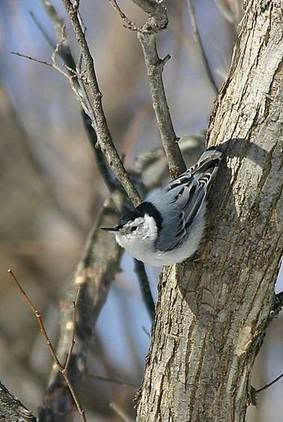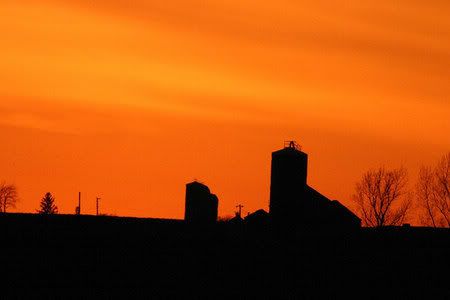The Gull of her dreams
It was Saturday. No obligations. Time to go get that Glaucous-Winged Gull! Since it had been sighted most consistently over the lunch hour at the same spot on Richmond Bay, that is where and when I would look. Heading down to the boat landing, my friend from Sauk City was again there. He'd been there for three hours, with no luck. This wasn't promising. Not promising at all. Lots of Herring and Ringed Billed, what my grandfather would call "flying rats," but no Glaucous-Winged.
To help non-birding readers understand the nature of this current obsession, it's not even listed in my Audubon Field Guide to Birds, Eastern Region. For a description, I have to bring out my National Geographic Field Guide to North American Birds. Every birder has several field guides. At the moment, I own four, and three specialized guides for my area. Its breeding area is shown to be the northwest coastal area of Canada and the Aleutians. Basically, one could take the map of North America and a colored magic marker, outline the west coast, and that would match the range map in my guide. I live in Wisconsin, so this is a bird way out of its range.
To pick it out of the crowd of around 500 Herring and Ring-Billeds, I needed to find a bird about the same size as the larger Herrings, but without any black wing-tips. Other birders who had been checking the other area gull flocks shortly joined us and one commented that he'd sure seen a lot of gull butts the past few days! Indeed!

Like this one, they were almost certain to be Ring-Billed or Herring Gull butts. I was beginning to accept that I probably will not see this rare gull, so I might as well relax and enjoy the birding. As if granting my wish, at that moment I looked up through the tree branches overhead and behind us, to see a huge kettle of Bald Eagles, about 50 of them, coursing toward the main channel of the Black River. Swirling and gliding overhead, catching thermals, it was a sight to inspire awe even among us Mississippi Flyway birders who see Eagles in multiples daily.
After that incredible show, Dan Jackson, the one who'd originally spotted the Glaucous-Winged and all the other unusual gulls, spotted a Thayers. I'd seen one about a week ago, but had to take his word for it, as it had already settled on the ice. Today I was able to follow it in flight, watch it settle, then confirm through a scope that I'd looked at the right bird. Yes!
After about an hour, I headed to look at another flock on the other side of the bridge. Nothing unusual there, but in keeping with my "enjoy the ride" mindset, I had fun taking photos of a few Ring-Billeds that were hanging about.

Three young men from out of the area had joined us at the boat landing, asking where Pettibone Park is located. They'd been told by some guy, not a birder, that there were "5000 gulls" down there. Really? Dan hadn't checked there at all. He was leaving to head home to family, but I guessed he'd take the long way home via Pettibone. After taking my fill of photos, I would, too.
Driving over the river and into the sanctuary, I was doubtful of the report we'd heard, until I saw a sheet of fluttering white swirl up from the lagoon. The size of the flock was probably exaggerated five-fold, but the ability to look closely was more than consolation. With the park activity, they were constantly swirling, which made for a fascinating show.

Other birds made use of the small area of open water in this small slough, including a lonely and confused Hooded Merganser, displaying in hopes of attracting attention, then rushing over to a female Mallard. He was run off quickly by several drakes whose mission was to discourage inter-species courtship. Though the day did not bring me the gull of my dreams, I did enjoy the spectacle of nature; one I hope will still be available for the birders of the last part of this century.
To help non-birding readers understand the nature of this current obsession, it's not even listed in my Audubon Field Guide to Birds, Eastern Region. For a description, I have to bring out my National Geographic Field Guide to North American Birds. Every birder has several field guides. At the moment, I own four, and three specialized guides for my area. Its breeding area is shown to be the northwest coastal area of Canada and the Aleutians. Basically, one could take the map of North America and a colored magic marker, outline the west coast, and that would match the range map in my guide. I live in Wisconsin, so this is a bird way out of its range.
To pick it out of the crowd of around 500 Herring and Ring-Billeds, I needed to find a bird about the same size as the larger Herrings, but without any black wing-tips. Other birders who had been checking the other area gull flocks shortly joined us and one commented that he'd sure seen a lot of gull butts the past few days! Indeed!

Like this one, they were almost certain to be Ring-Billed or Herring Gull butts. I was beginning to accept that I probably will not see this rare gull, so I might as well relax and enjoy the birding. As if granting my wish, at that moment I looked up through the tree branches overhead and behind us, to see a huge kettle of Bald Eagles, about 50 of them, coursing toward the main channel of the Black River. Swirling and gliding overhead, catching thermals, it was a sight to inspire awe even among us Mississippi Flyway birders who see Eagles in multiples daily.
After that incredible show, Dan Jackson, the one who'd originally spotted the Glaucous-Winged and all the other unusual gulls, spotted a Thayers. I'd seen one about a week ago, but had to take his word for it, as it had already settled on the ice. Today I was able to follow it in flight, watch it settle, then confirm through a scope that I'd looked at the right bird. Yes!
After about an hour, I headed to look at another flock on the other side of the bridge. Nothing unusual there, but in keeping with my "enjoy the ride" mindset, I had fun taking photos of a few Ring-Billeds that were hanging about.

Three young men from out of the area had joined us at the boat landing, asking where Pettibone Park is located. They'd been told by some guy, not a birder, that there were "5000 gulls" down there. Really? Dan hadn't checked there at all. He was leaving to head home to family, but I guessed he'd take the long way home via Pettibone. After taking my fill of photos, I would, too.
Driving over the river and into the sanctuary, I was doubtful of the report we'd heard, until I saw a sheet of fluttering white swirl up from the lagoon. The size of the flock was probably exaggerated five-fold, but the ability to look closely was more than consolation. With the park activity, they were constantly swirling, which made for a fascinating show.

Other birds made use of the small area of open water in this small slough, including a lonely and confused Hooded Merganser, displaying in hopes of attracting attention, then rushing over to a female Mallard. He was run off quickly by several drakes whose mission was to discourage inter-species courtship. Though the day did not bring me the gull of my dreams, I did enjoy the spectacle of nature; one I hope will still be available for the birders of the last part of this century.













